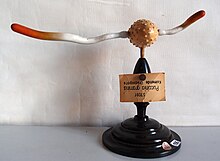Uredie
The uredie or uredium is a form of spore storage in rust fungi (Pucciniales). It occurs as a dikaryotic by- crop form in some species and is primarily used for the spatial distribution of fungi, which, as endoparasites, feed on plant metabolites. Uredia consist of a two-nucleus mycelium and usually form rounded, prickly uredospores that are immediately germinable. In the development cycle of the rust fungi, uredia follow spermogonia and aecia , from whose spores they arise. Their spores in turn form the starting point for the development of telia , in which sexual reproduction occurs. Where other spore stores are not known or cannot be clearly distinguished, uredia are used for the taxonomic classification of rust fungus species.
Development and construction

Uredia consist of a binuclear mycelium that is anchored between the host cells and germinates from aeciospores . They grow on the main host of the respective type of fungus, i.e. the host plant on which the telia arise. The binuclear uredospores produced by them are mostly round, unicellular and spiky. Where the main and secondary host are identical, they are partially indistinguishable from the aeciospores, which is why mycology there speaks of aecidioid uredospores. As a rule, uredospores only serve to spread the fungal mycelium: They are produced relatively quickly and are capable of germination without additional fertilization or resting phase, which means that the fungus can quickly colonize other plants. Occasionally, however, particularly large and thick-walled spores occur, which are mainly used to survive frost or drought and are known as amphispores. The uredospores in turn germinate in a binuclear mycelium, from which either new uredia or telia develop. Telia can also arise from the same mycelium that has previously produced uredospores. The teliospores produced in the telia are the site of karyogamy and meiosis , which complete the development cycle of the fungus. Uredia, unlike spermogonia, aecia and telia, are not absolutely necessary for the development of a rust fungus and are therefore absent in some species.
Taxonomic meaning
Uredien are less important for the taxonomic classification of the rust fungus species than the Telien or Aecien. However, where the latter are unknown, they serve to distinguish the various species that then the anamorphic - form genus Uredo provided. In addition, they can be an important distinguishing criterion if other spore beds of different species are so similar that they can not be distinguished morphologically .
swell
- Heinrich Dörfelt , Gottfried Jetschke (Ed.): Dictionary of mycology. 2nd Edition. Spectrum Academic Publishing House, Heidelberg / Berlin 2001, ISBN 3-8274-0920-9 .
